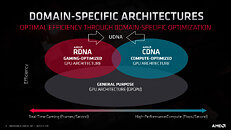- Joined
- Aug 19, 2017
- Messages
- 2,808 (1.02/day)
According to new information from Tom's Hardware, AMD has announced plans to unify its consumer-focused gaming RDNA and data center CDNA graphics architectures into a single, unified design called "UDNA." The announcement was made by AMD's Jack Huynh, Senior Vice President and General Manager of the Computing and Graphics Business Group, at IFA 2024 in Berlin. The goal of the new UDNA architecture is to provide a single focus point for developers so that each optimized application can run on consumer-grade GPU like Radeon RX 7900XTX as well as high-end data center GPU like Instinct MI300. This will create a unification similar to NVIDIA's CUDA, which enables CUDA-focused developers to run applications on everything ranging from laptops to data centers.

According to Jack Huynh, AMD "made some mistakes with the RDNA side; each time we change the memory hierarchy, the subsystem, it has to reset the matrix on the optimizations. I don't want to do that. So, going forward, we're thinking about not just RDNA 5, RDNA 6, RDNA 7, but UDNA 6 and UDNA 7. We plan the next three generations because once we get the optimizations, I don't want to have to change the memory hierarchy, and then we lose a lot of optimizations. So, we're kind of forcing that issue about full forward and backward compatibility. We do that on Xbox today; it's very doable but requires advanced planning. It's a lot more work to do, but that's the direction we're going."
When AMD originally separated CDNA from RDNA, the company wanted to create two separate entities and thought it would be easier to manage. However, it couldn't be further from the truth. Having two separate teams for optimizations is a nightmare both logistically and engineering-wise. Hence, the shift to a monolithic structure of GPU architectures is beneficial to the company in the long term and will ease the development of newer products with both gaming-focused and compute-focused teams at work. This strategy is similar to NVIDIA's CUDA, which has maintained its architecture line in a single lane, with added special accelerators for AI or/or ray tracing, which AMD also plans to do.
View at TechPowerUp Main Site | Source
Jack Huynh said:So, part of a big change at AMD is today we have a CDNA architecture for our Instinct data center GPUs and RDNA for the consumer stuff. It's forked. Going forward, we will call it UDNA. There'll be one unified architecture, both Instinct and client [consumer]. We'll unify it so that it will be so much easier for developers versus today, where they have to choose and value is not improving.

According to Jack Huynh, AMD "made some mistakes with the RDNA side; each time we change the memory hierarchy, the subsystem, it has to reset the matrix on the optimizations. I don't want to do that. So, going forward, we're thinking about not just RDNA 5, RDNA 6, RDNA 7, but UDNA 6 and UDNA 7. We plan the next three generations because once we get the optimizations, I don't want to have to change the memory hierarchy, and then we lose a lot of optimizations. So, we're kind of forcing that issue about full forward and backward compatibility. We do that on Xbox today; it's very doable but requires advanced planning. It's a lot more work to do, but that's the direction we're going."
When AMD originally separated CDNA from RDNA, the company wanted to create two separate entities and thought it would be easier to manage. However, it couldn't be further from the truth. Having two separate teams for optimizations is a nightmare both logistically and engineering-wise. Hence, the shift to a monolithic structure of GPU architectures is beneficial to the company in the long term and will ease the development of newer products with both gaming-focused and compute-focused teams at work. This strategy is similar to NVIDIA's CUDA, which has maintained its architecture line in a single lane, with added special accelerators for AI or/or ray tracing, which AMD also plans to do.
View at TechPowerUp Main Site | Source







 Honestly it makes sense. AMD is smaller than Nvidia with more limited resources. So having to optimize software for two architectures made little sense from a manpower standpoint. The question is will the UDNA architechture be able to perform well in both avenues. Whatever the case maybe, I hope AMD can get the GPU aspect of their business together. GPUs desparately need some short of shake up.
Honestly it makes sense. AMD is smaller than Nvidia with more limited resources. So having to optimize software for two architectures made little sense from a manpower standpoint. The question is will the UDNA architechture be able to perform well in both avenues. Whatever the case maybe, I hope AMD can get the GPU aspect of their business together. GPUs desparately need some short of shake up.
